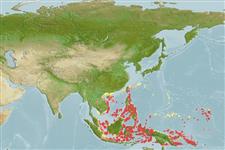Teleostei (teleosts) >
Eupercaria/misc (Various families in series Eupercaria) >
Labridae (Wrasses) > Corinae
Etymology: Halichoeres: Greek, als, alis = salt + Greek, choiros = pig (Ref. 45335).
Eponymy: Charles Wallace Richmond (1868–1932) was an American ornithologist who specialised in being a nomenclaturist and bibliographer. [...] (Ref. 128868), visit book page.
More on authors: Fowler & Bean.
Environment: milieu / climate zone / depth range / distribution range
Ecology
Marine; reef-associated; depth range 1 - 15 m (Ref. 90102). Tropical; 30°N - 9°S
Western Pacific: Java, Philippines, Ryukyu Islands, Moluccas, Palau (Belau), Truk, Pohnpei, and Kwajalein.
Size / Weight / Age
Maturity: Lm ? range ? - ? cm
Max length : 19.0 cm TL male/unsexed; (Ref. 9710)
Dorsal spines (total): 9; Dorsal soft rays (total): 12; Anal spines: 3; Anal soft rays: 12. Males are recognized by the orange-brown head and blue lines that are chain-like along the body. Juveniles and females have an orange to yellow anal fin. The snout is more pointed compared to similar species (Ref. 48636). Terminal males have a distinctive concave head profile (Ref. 1602).
Occurs in shallow lagoon and channel reefs, up to a depth of at least 12 m, with rich soft-coral growth. Occurs in small loose groups (Ref. 48636).
Life cycle and mating behavior
Maturity | Reproduction | Spawning | Eggs | Fecundity | Larvae
Distinct pairing during breeding (Ref. 205).
Myers, R.F., 1991. Micronesian reef fishes. Second Ed. Coral Graphics, Barrigada, Guam. 298 p. (Ref. 1602)
IUCN Red List Status (Ref. 130435: Version 2024-1)
Threat to humans
Harmless
Human uses
Tools
Special reports
Download XML
Internet sources
Estimates based on models
Preferred temperature (Ref.
123201): 27.5 - 29.3, mean 28.8 °C (based on 1088 cells).
Phylogenetic diversity index (Ref.
82804): PD
50 = 0.5000 [Uniqueness, from 0.5 = low to 2.0 = high].
Bayesian length-weight: a=0.00977 (0.00468 - 0.02039), b=3.09 (2.92 - 3.26), in cm total length, based on LWR estimates for this Genus-body shape (Ref.
93245).
Trophic level (Ref.
69278): 3.5 ±0.5 se; based on size and trophs of closest relatives
Resilience (Ref.
120179): Medium, minimum population doubling time 1.4 - 4.4 years (Preliminary K or Fecundity.).
Fishing Vulnerability (Ref.
59153): Low vulnerability (10 of 100).
Nutrients (Ref.
124155): Calcium = 78 [46, 131] mg/100g; Iron = 0.681 [0.394, 1.260] mg/100g; Protein = 18.5 [15.6, 20.7] %; Omega3 = 0.14 [0.09, 0.22] g/100g; Selenium = 20.9 [12.6, 37.9] μg/100g; VitaminA = 136 [42, 493] μg/100g; Zinc = 1.66 [1.15, 2.63] mg/100g (wet weight);
